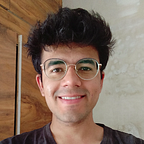MONTHLY LEARNINGS IN GOOGLE SUMMER OF CODE 2020
Mapping my Journey through GSoC’20!
It’s a new day, it’s a new plan, I’ve been waiting for you.. Here I am.
Hello all, I am Aryan Gupta, a 2nd year student of Cluster Innovation Centre, University of Delhi. I am pursuing B.Tech in I.T. & M.I.(Information Technology and Mathematical Innovation) with a minor in System Biology.
This is a journal of my time working under the program Google Summer of Code 2020.
I call this a journal, because.. its the middle of the pandemic. We all are stuck at home. Time moves really slow nowadays. And I’m hoping this keeps me focused and tracks my time and progress well.
About the Program : Google Summer of Code is a global program focused on bringing more student developers into open source software development. Students get to work with an open source organisation on a 3 month programming project during their break from school.
I wouldn’t like to bore you with technical details; how to apply etc. Chances are you searched for this article or it was recommended to you, so you probably already know it. For a newbie who has chanced on this article, do first take a look at this for context.
Right, lets get started!
This year, I will be working with Mission Support System, a sub org of Python Software Foundation. I am really excited for this opportunity! And honestly, a bit nervous too :))
About My Organisation : Mission Support System
Mission Support System (MSS) has been written and is used by atmospheric scientists. The MSS software helps to plan scientific flights used for measuring atmospheric parameters. Its fully Open Source.
The measurement of relevant parameters, for example the chemical composition of trace gases, temperature or aerosol particle characteristics, are needed to improve the scientific understanding of the processes in the atmosphere. This is of significant importance for the understanding for example of climate change or the recovery of the ozone hole.
The research aircrafts typically carry a comprehensive scientific payload comprised of data acquisition instruments by different companies and research institutions.
Typically, scientific research flights are conducted to answer different scientific questions. Forecasts of relevant parameters by a model simulation for a specific location give hints where to fly, to answer the scientific questions by measurements.
A lot of other conditions apply to research flights, that concern flight altitude and range, ambient temperature, flight permissions in different flight information regions and aircraft traffic routes. Thus proposed flight paths are necessary while conducting research.
MSS optimises the output of research flights by displaying planned flight routes based on the above factors. This does two important things : reduces flight hours to answer scientific questions, and saves a lot of taxpayer money.
You can read more about MSS in this research paper.
And I have this wonderful opportunity to contribute to this noble work!!
About My Project : Enhancing KML Support
Here’s the link to my Project, right up on the GSoC page :))
KML stands for Keyhole Markup Language. KML has been derived from XML and is a file format to display geographic data in browsers or geographic information systems such as Arcgis or in my case, MSS.
Its basically XML for geographic data. Softwares are used to parse data in KML Files and display the information visually.
MSS visualizes KML data in 2D in the form of Point, Lines and Multi-Geometries. Below is a plot of a basic KML File.
My project focuses on enhancing the KML experience. Right from the UI to the finer points (pardon) of the visualization!
My main aim is to provide support for Multiple KML Files. At present, only a single KML file can be executed and displayed, which in a way, does not give the full picture. With the new support, different KML Files could be displayed simultaneously with different colours and references.
You can read my Proposal for this project here.
I think I’ll keep it till here for this chapter; Next, I’ll be writing on my weekly experiences and learnings. Stay tuned to know more :))
Edit : During my GSoC , I wrote this blog realtime, for every month — with all the challenges and the way to persevere through. If you wish to read about my experiences and learnings, check out the following blogs :
Mapping my Journey through GSoC’20 : Pilot.
My First Month as a Student Software Developer!
medium.com
Hope you enjoy reading it as much as I enjoyed writing :))
